FORD Windstar 2003 User Manual v.2
|
Table of Contents |
|
|
Introduction |
4 |
|
|
|
|
Instrument Cluster |
10 |
|
|
Warning and control lights |
10 |
Gauges |
14 |
|
|
Entertainment Systems |
16 |
|
|
AM/FM stereo cassette with CD |
16 |
AM/FM stereo cassette |
18 |
AM/FM stereo with CD |
25 |
Rear seat controls |
28 |
|
|
Climate Controls |
31 |
|
|
Manual heating and air conditioning |
31 |
Rear window defroster |
35 |
|
|
Lights |
36 |
|
|
Headlamps |
36 |
Turn signal control |
39 |
Bulb replacement |
41 |
|
|
Driver Controls |
45 |
|
|
Windshield wiper/washer control |
45 |
Steering wheel adjustment |
46 |
Power windows |
53 |
Mirrors |
54 |
Speed control |
56 |
Message center |
63 |
|
|
Locks and Security |
77 |
|
|
Keys |
77 |
Locks |
77 |
Anti-theft system |
79 |
1

Table of Contents
Seating and Safety Restraints |
89 |
|
|
Seating |
89 |
Safety restraints |
99 |
Air bags |
112 |
Child restraints |
118 |
|
|
Driving |
132 |
|
|
Starting |
132 |
Brakes |
135 |
Traction control |
137 |
Transmission operation |
140 |
Trailer towing |
147 |
|
|
Roadside Emergencies |
152 |
|
|
Getting roadside assistance |
152 |
Hazard flasher switch |
153 |
Fuel pump shut-off switch |
153 |
Fuses and relays |
154 |
Changing tires |
163 |
Jump starting |
169 |
Wrecker towing |
174 |
|
|
Customer Assistance |
175 |
|
|
Reporting safety defects (U.S. only) |
183 |
|
|
Cleaning |
184 |
|
|
2
|
Table of Contents |
|
|
Maintenance and Specifications |
190 |
|
|
Engine compartment |
192 |
Engine oil |
193 |
Battery |
196 |
Fuel information |
203 |
Low tire warning system |
218 |
Part numbers |
223 |
Refill capacities |
224 |
Lubricant specifications |
225 |
|
|
Accessories |
230 |
|
|
|
|
Index |
233 |
|
|
All rights reserved. Reproduction by any means, electronic or mechanical including photocopying, recording or by any information storage and retrieval system or translation in whole or part is not permitted without written authorization from Ford Motor Company. Ford may change the contents without notice and without incurring obligation.
Copyright © 2002 Ford Motor Company
3
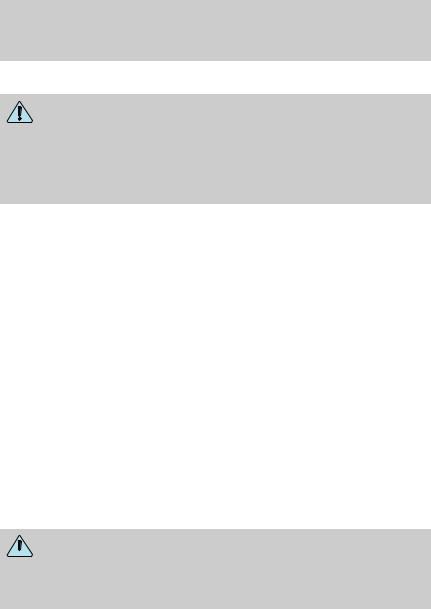
Introduction
CALIFORNIA Proposition 65 Warning
WARNING: Engine exhaust, some of its constituents, and certain vehicle components contain or emit chemicals known to
the State of California to cause cancer and birth defects or other reproductive harm. In addition, certain fluids contained in vehicles and certain products of component wear contain or emit chemicals known to the State of California to cause cancer and birth defects or other reproductive harm.
CONGRATULATIONS
Congratulations on acquiring your new Ford. Please take the time to get well acquainted with your vehicle by reading this handbook. The more you know and understand about your vehicle the greater the safety and pleasure you will derive from driving it.
For more information on Ford Motor Company and its products visit the following website:
•In the United States: www.ford.com
•In Canada: www.ford.ca
•In Australia: www.ford.com.au
•In Mexico: www.ford.com.mx
Additional owner information is given in separate publications.
This Owner’s Guide describes every option and model variant available and therefore some of the items covered may not apply to your particular vehicle. Furthermore, due to printing cycles it may describe options before they are generally available.
Remember to pass on the Owner’s Guide when reselling the vehicle. It is an integral part of the vehicle.
Fuel pump shut-off switch In the event of an accident the  safety switch will automatically cut off the fuel supply to the engine. The switch can also be activated through sudden vibration (e.g. collision when parking). To reset the switch, refer to the Fuel
safety switch will automatically cut off the fuel supply to the engine. The switch can also be activated through sudden vibration (e.g. collision when parking). To reset the switch, refer to the Fuel
pump shut-off switch in the Roadside emergencies chapter.
4

Introduction
SAFETY AND ENVIRONMENT PROTECTION
 Warning symbols in this guide
Warning symbols in this guide
How can you reduce the risk of personal injury and prevent possible damage to others, your vehicle and its equipment? In this guide, answers to such questions are contained in comments highlighted by the warning triangle symbol. These comments should be read and observed.
 Warning symbols on your vehicle
Warning symbols on your vehicle
When you see this symbol, it is imperative that you consult the relevant section of this guide before touching or attempting adjustment of any kind.
Protecting the environment
We must all play our part in protecting the environment. Correct vehicle usage and the authorized disposal of waste cleaning and lubrication materials are significant
steps towards this aim. Information in this respect is highlighted in this guide with the tree symbol.
BREAKING-IN YOUR VEHICLE
Your vehicle does not need an extensive break-in. Try not to drive continuously at the same speed for the first 1,600 km (1,000 miles) of new vehicle operation. Vary your speed to allow parts to adjust themselves to other parts.
Drive your new vehicle at least 800 km (500 miles) before towing a trailer.
Do not add friction modifier compounds or special break-in oils during the first few thousand kilometers (miles) of operation, since these additives may prevent piston ring seating. See Engine oil in the Maintenance and specifications chapter for more information on oil usage.
5

Introduction
SPECIAL NOTICES
Emission warranty
The New Vehicle Limited Warranty includes Bumper-to-Bumper Coverage, Safety Restraint Coverage, Corrosion Coverage, and 7.3L Power Stroke Diesel Engine Coverage. In addition, your vehicle is eligible for Emissions Defect and Emissions Performance Warranties. For a detailed description of what is covered and what is not covered, refer to the Warranty Guide that is provided to you along with your Owner’s Guide.
Data Recording
Computers in your vehicle are capable of recording detailed data potentially including but not limited to information such as:
•the use of restraint systems including seat belts by the driver and passengers,
•information about the performance of various systems and modules in the vehicle, and
•information related to engine, throttle, steering, brake or other system status.
Any of this information could potentially including information regarding how the driver operates the vehicle potentially including but not limited to information regarding vehicle speed, brake or accelerator application or steering input. This information may be stored during regular operation or in a crash or near crash event.
This stored information may be read out and used by:
•Ford Motor Company.
•service and repair facilities.
•law enforcement or government agencies.
•others who may assert a right or obtain your consent to know such information.
6

Introduction
Special instructions
For your added safety, your vehicle is fitted with sophisticated electronic controls.
Please read the section Supplemental Restraint System (SRS) in the Seating and safety restraints chapter. Failure to follow
the specific warnings and instructions could result in personal injury.
Front seat mounted rear facing child or infant seats should NEVER be used in front of a passenger side air bag unless the
air bag can be and is turned OFF.
MIDDLE EAST/NORTH AFRICA VEHICLE SPECIFIC INFORMATION
For your particular global region, your vehicle may be equipped with features and options that are different from the ones that are described in this Owner Guide; therefore, a supplement has been supplied that complements this book. By referring to the pages in the provided supplement, you can properly identify those features, recommendations and specifications that are unique to your vehicle. Refer to this Owner
Guide for all other required information and warnings.
7
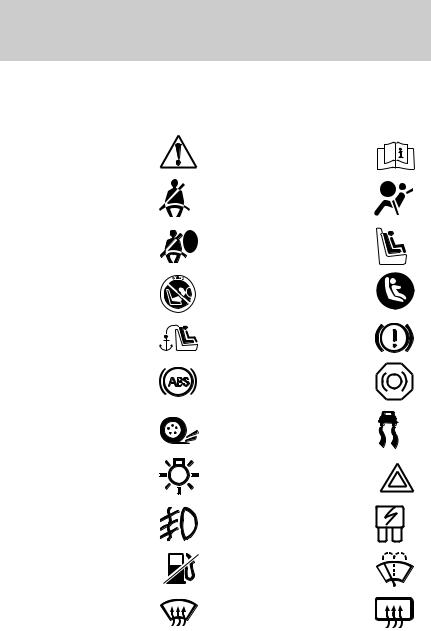
Introduction
These are some of the symbols you may see on your vehicle.
Vehicle Symbol Glossary |
||
Safety Alert |
See Owner’s Guide |
|
Fasten Safety Belt |
Air Bag-Front |
|
Air Bag-Side |
Child Seat |
|
Child Seat Installation |
Child Seat Lower |
|
Warning |
Anchor |
|
Child Seat Tether |
Brake System |
|
Anchor |
||
|
||
Anti-Lock Brake System |
Brake Fluid - |
|
Non-Petroleum Based |
||
|
||
Traction Control |
AdvanceTrac |
|
Master Lighting Switch |
Hazard Warning Flasher |
|
Fog Lamps-Front |
Fuse Compartment |
|
Fuel Pump Reset |
Windshield Wash/Wipe |
|
Windshield |
Rear Window |
|
Defrost/Demist |
Defrost/Demist |
|
8

Introduction
Vehicle Symbol Glossary
Power Windows |
Power Window Lockout |
|
Front/Rear |
||
|
||
Child Safety Door |
Interior Luggage |
|
Compartment Release |
||
Lock/Unlock |
||
Symbol |
||
|
||
Panic Alarm |
Engine Oil |
|
Engine Coolant |
Engine Coolant |
|
Temperature |
||
|
||
Do Not Open When Hot |
Battery |
|
Avoid Smoking, Flames, |
Battery Acid |
|
or Sparks |
||
|
||
Explosive Gas |
Fan Warning |
|
Power Steering Fluid |
Maintain Correct Fluid |
|
Level |
||
|
||
Emission System |
Engine Air Filter |
|
Passenger Compartment |
Jack |
|
Air Filter |
||
|
||
Check fuel cap |
Low tire warning |
MAX
MIN
9

Instrument Cluster
WARNING LIGHTS AND CHIMES
CHECK |
|
FUEL |
O/D |
CAP |
|
|
OFF |
|
|
4 |
5 |
6 |
|
40 |
|
60 |
|
|
F |
FUEL |
3 |
TRAC |
7 |
80 |
80 |
TEMP |
H |
||
ACTIVE |
|
|
|
BRAKE 120 |
|
|||||
|
2 |
TRAC |
|
|
|
20 40 |
|
100 |
|
|
|
OFF |
|
|
|
|
|
|
|||
E |
1 |
RPMX1000 |
THEFT |
|
|
160 |
|
|
||
|
|
|
|
|
||||||
|
|
|
|
|
|
MPH |
|
km/h |
|
|
|
|
|
|
|
|
|
|
200120 |
|
|



 mi
mi
Warning lights and gauges can alert you to a vehicle condition that may become serious enough to cause expensive repairs. A warning light may illuminate when a problem exists with one of your vehicle’s functions.
Many lights will illuminate when you start your vehicle to make sure the bulb works. If any light remains on after starting the vehicle, have the respective system inspected immediately.
Check engine: The Check Engine indicator light illuminates when the ignition is first turned to the ON position to check the bulb. Solid
illumination after the engine is started indicates the On Board Diagnostics System (OBD-II) has detected a malfunction. Refer to On board diagnostics (OBD-II) in the Maintenance and Specifications chapter. If the light is blinking, engine misfire is occurring which could damage your catalytic converter. Drive in a moderate fashion (avoid heavy acceleration and deceleration) and have your vehicle serviced immediately.
Under engine misfire conditions, excessive exhaust temperatures could damage the catalytic converter, the fuel system, interior
floor coverings or other vehicle components, possibly causing a fire.
Check fuel cap: Illuminates when |
CHECK |
the fuel cap may not be properly |
FUEL |
installed. Continued driving with |
|
this light on may cause the Check |
CAP |
engine warning light to come on, |
|
refer to Fuel filler cap in the Maintenance and Specification chapter.
10

Instrument Cluster
Brake system warning light: To confirm the brake system warning
light is functional, it will momentarily illuminate when the
ignition is turned to the ON position when the engine is not running, or in a position between ON and START, or by applying the parking brake when the ignition is turned to the ON position. If the brake system warning light does not illuminate at this time, seek service immediately from your dealership. Illumination after releasing the parking brake indicates low brake fluid level and the brake system should be inspected immediately by your servicing dealership.
Driving a vehicle with the brake system warning light on is dangerous. A significant decrease in braking performance may
occur. It will take you longer to stop the vehicle. Have the vehicle checked by your dealer immediately.
Anti-lock brake system: If the
ABS light stays illuminated or ABS continues to flash, a malfunction has
been detected, have the system serviced immediately. Normal
braking is still functional unless the brake warning light also is illuminated.
Air bag readiness: If this light fails to illuminate when ignition is turned to ON, continues to flash or remains on, have the system serviced
immediately. A chime will also sound when a malfunction in the supplemental restraint system has been detected.
Safety belt: Reminds you to fasten your safety belt. A chime will also sound to remind you to fasten your safety belt.
Charging system: Illuminates when the battery is not charging properly.
11

Instrument Cluster
Engine oil pressure: Illuminates when the oil pressure falls below the normal range, refer to Engine oil in the Maintenance and specifications chapter.
Traction Control or |
TRAC |
AdvanceTrac active |
ACTIVE |
(if equipped): Illuminates when |
the Traction Control is active,
refer to the Driving chapter for more information.
Traction Control or AdvanceTrac off light
(if equipped): Illuminates when the Traction Control has been
disabled (by the driver or as a result of a system failure). Refer to the Driving chapter for more information.
Low tire warning: Illuminates when the low tire warning system is enabled. If the light remains on while driving, the tire pressure should be checked, refer to Low
tire warning in the Maintenance and Specifications chapter.
Low fuel: Illuminates when the fuel level in the fuel tank is at or near empty (refer to Fuel gauge in this chapter).
Speed control: Illuminates when the speed control is engaged. Turns off when the speed control system is disengaged.
O/D off: Illuminates when the overdrive function of the transmission has been turned off.
O/D OFF
12

Instrument Cluster
Low washer fluid: Illuminates when the windshield washer fluid is low.
Door ajar: Illuminates when the ignition is in the ON position and any door is open.
Anti-theft system: Flashes when the Securilock Passive Anti-theft System has been activated.
Turn signal: Illuminates when the left or right turn signal or the hazard lights are turned on. If the
indicators stay on or flash faster, check for a burned out bulb.
High beams: Illuminates when the high beam headlamps are turned on.
Key-in-ignition warning chime: Sounds when the key is left in the ignition in the OFF/LOCK or ACC position and the driver’s door is opened.
Headlamps on warning chime: Sounds when the headlamps or parking lamps are on, the ignition is off (and the key is not in the ignition) and the driver’s door is opened.
Turn signal warning chime: Sounds when the turn signal lever has been activated to signal a turn and not turned off after the vehicle is driven more than 0.8 km (1/2 mile).
13

Instrument Cluster
GAUGES
|
CHECK |
|
|
|
|
|
|
|
|
|
|
|
|
FUEL |
|
|
|
|
|
|
|
|
|
|
|
CAP |
|
|
|
|
|
|
|
O/D |
|
|
|
|
|
|
|
|
|
|
60 |
OFF |
|
|
|
3 |
4 |
5 |
6 |
|
40 |
|
|
|
|
F |
FUEL |
|
TRAC |
7 |
80 |
80 |
TEMP |
H |
|||
TRAC |
ACTIVE |
|
|
|
BRAKE 120 |
|
|||||
|
2 |
|
|
|
|
20 40 |
|
|
100 |
|
|
|
OFF |
|
|
|
|
|
|
|
|||
E |
1 |
|
RPMX1000 |
THEFT |
|
|
160 |
|
|||
|
|
|
|
|
|
||||||
|
|
|
|
|
|
|
MPH |
|
km/h |
|
|
|
|
|
|
|
|
|
|
|
|
200120 |
|



 mi
mi
Speedometer: Indicates the current vehicle speed.
Engine coolant temperature gauge: Indicates engine coolant temperature. At normal operating
temperature, the needle will be in TEMP H the normal range (between “H” and
“C”). If it enters the red section, the engine is overheating. Stop the vehicle as soon as safely possible, switch off the engine and let the engine cool.
Never remove the coolant reservoir cap while the engine is running or hot.
14

Instrument Cluster
Odometer: Registers the total
kilometers (miles) of the vehicle.
Trip odometer: Registers the kilometers (miles) of individual journeys. To reset, depress the control.
Low tire warning reset: May be used to reset the Low Tire Warning
System, refer to Low Tire Warning in the Maintenance and Specifications chapter.
Tachometer: Indicates the engine speed in revolutions per minute. Driving with your tachometer pointer continuously at the top of the scale may damage the engine.
Fuel gauge: Indicates approximately how much fuel is left in the fuel tank (when the ignition is in the ON position). The fuel gauge may vary slightly when the vehicle is in motion or on a grade.
The arrow near the fuel pump icon indicates which side of the vehicle the fuel filler door is located.
|
4 |
5 |
6 |
|
3 |
|
7 |
|
2 |
|
|
|
|
|
|
1 |
RPMX1000 |
||
F FUEL
E
Refer to Filling the tank in the Maintenance and Specifications chapter for more information..
15

Entertainment Systems
AM/FM STEREO
1. Seek: Press  /
/  to find the
to find the
next listenable station down/up the frequency band.
2.Tune: Press  /
/  to manually adjust the radio frequency down/up.
to manually adjust the radio frequency down/up.
3.AM/FM: Press to choose a frequency band in radio mode.
4.Memory preset buttons: To set
a station: Select frequency band |
1 |
|
|
AM/FM1/FM2; tune to a station, |
|
press and hold a preset button until sound returns.
AM/FM
2 |
3 |
4 |
16
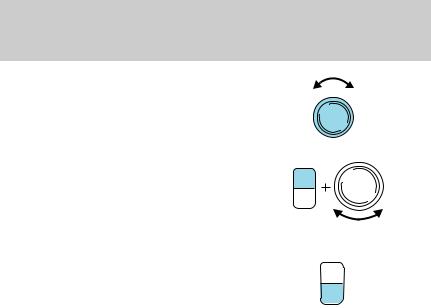
Entertainment Systems
5.Power/volume: Press to turn ON/OFF; turn to increase or decrease volume levels.
6.Tone: Press TONE until the desired level — Bass, Treble, Fade appears on the display. Turn the volume control to raise/lower the levels, or to move the audio sound from the right to left or the front to back (if equipped).
7.CLK (Clock): To set the hour, press and hold CLK until CLOCK SET appears in the display. Press
SEEK to decrease  or increase
or increase  the hours.
the hours.
VOL
PUSH
ON
VOL
PUSH
ON
TONE
CLK
TONE
CLK
To set the minute, press and hold CLK until CLOCK SET appears in the display. Press TUNE to decrease  or increase
or increase  the minutes.
the minutes.
17

Entertainment Systems
AM/FM STEREO CASSETTE
12 |
13 |
14 |
15 |
16 |
17 |
1 |
2 |
3 |
4 |
11
10
9
VOL - PUSH ON |
|
|
AM |
FM1 |
ST |
BASS TREB |
|
|
FM |
|
|
SEEK |
|
|
SCAN |
EJ |
|
TUNE
CLK
BAL FADE
TAPE
AMS
SIDE 1 - 2
REW FF
1 |
2 |
3 |
4 |
5 |
6 |
8 |
7 |
6 |
5 |
1.Balance: Press to shift sound to the left/right speakers.
2.Fade: Press to shift sound to the rear/front speakers.
3.CLK: To set the hour, press and hold CLK. Then press SEEK to
decrease  or increase
or increase  the hours.
the hours.
CLK
To set the minute, press and hold CLK and press TUNE to decrease 
or increase |
the minutes. |
18
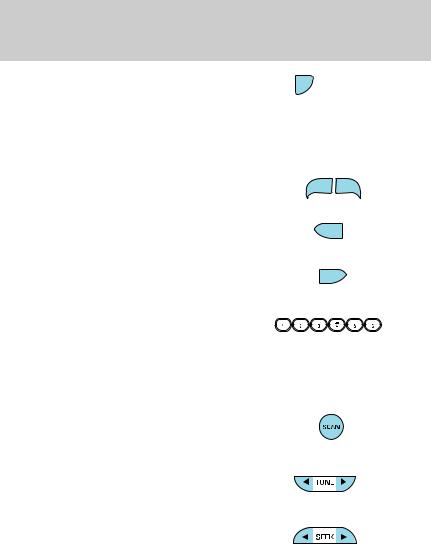
5.Side 1–2: Press to change tape direction.
6.REW (rewind): Press to rewind the tape.
FF (fast forward): Press to advance the tape.
SIDE 1 - 2
REW
FF
7. Memory preset buttons: To set a station: Select frequency band AM/FM1/FM2; tune to a station,
press and hold a preset button until sound returns.
8. Dolby noise reduction: Works in tape mode only. Reduces tape noise and hiss; press to activate/deactivate.
Dolby noise reduction: Works in tape mode only. Reduces tape noise and hiss; press to activate/deactivate.
9.Scan: Press SCAN to hear a brief
sampling of all listenable radio stations or all tape selections. Press again to stop.
10.Tune: Works in radio mode only. Press TUNE  /
/  to change frequency down/up
to change frequency down/up
11.Seek: Press and
release  /
/  for previous/next strong station, selection or track.
for previous/next strong station, selection or track.
19

Entertainment Systems
12.Power/volume: Press to turn ON/OFF; turn to increase or decrease volume levels.
13.AM/FM: Press to choose a frequency band in radio mode.
14.Bass: Press  /
/  to decrease/increase the bass output.
to decrease/increase the bass output.
15.Treble: Press  /
/  to decrease/increase the treble output.
to decrease/increase the treble output.
16.EJ (Eject): Press to eject a tape.
EJ
17. Cassette door: Insert a cassette into the cassette door.
20
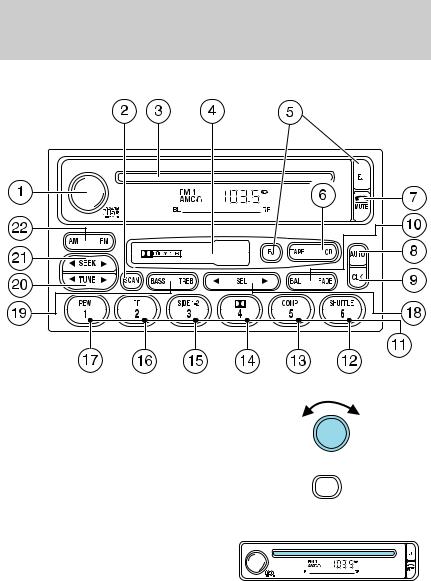
Entertainment Systems
PREMIUM AM/FM STEREO/CASSETTE/SINGLE CD
1.Power/volume: Press to turn ON/OFF; turn to increase/decrease volume.
2.Scan: Press to hear a brief sampling of all listenable stations, tape selections or CD tracks. Press again to stop.
3.CD Door: Insert a CD with the label side up.
SCAN
21

Entertainment Systems
4. Cassette door: Insert the cassette with the opening to the right.
5. Eject: Press to eject the cassette/CD. The radio will resume playing.
6. Tape: Press to start tape play. Press to stop tape during rewind/fast forward.
CD: Press to start CD play. With the dual media audio, press CD to toggle between single CD and CD changer play (if equipped).
7. Mute: Press to MUTE playing media; press again return to playing media.
8. Auto: Press to set first six strongest stations (if available) into AM, FM1 or FM2 memory buttons; press again to return to normal stations.
9. Clock: Press and hold to set the
clock. Press the |
SEEK to |
|
|
decrease hours or SEEK |
to |
||
increase hours. Press the |
|
TUNE |
|
to decrease minutes or TUNE |
to |
||
increase minutes. If your vehicle has a stand alone clock this control will not function.
22
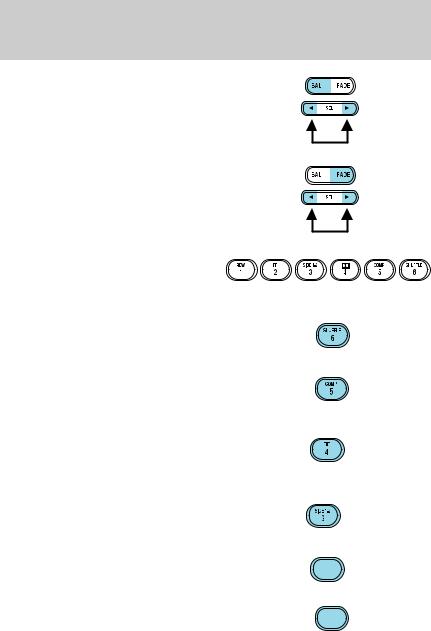
Entertainment Systems
10. Balance: Press BAL; then press SEL  /
/  to shift sound to the left/right speakers.
to shift sound to the left/right speakers.
Fade: Press FADE; then press SEL  /
/  to shift sound to the rear/front speakers.
to shift sound to the rear/front speakers.
11. Memory preset buttons: To set a station: Select frequency band AM/FM, tune to a station, press and
hold a preset button until sound returns.
12.Shuffle (CD): Press to play tracks in random order.
13.Compression (CD): Press to bring soft and loud passages together for a more consistent listening level.
14. Dolby noise reduction:
Dolby noise reduction:
Works in tape mode only. Reduces tape noise and hiss; press to activate/deactivate.
15.Side 1–2: Works in tape mode only. Press to play reverse side of the tape.
16.Fast Forward (FF): Press for a slow advance, press and hold for a fast advance.
17.Rewind (REW): Press for a slow rewind, press and hold for a fast rewind.
FF
2
REW
1
23

Entertainment Systems
18.Select (SEL): Use with Bass, Treble, Balance and Fade controls.
19.Bass: Press BASS; then press SEL  /
/  to decrease/increase the bass output.
to decrease/increase the bass output.
Treble: Press TREB; then press SEL  /
/  to decrease/increase the treble output.
to decrease/increase the treble output.
20.Tune: Works in radio mode only. Press TUNE  /
/  to change frequency down/up.
to change frequency down/up.
21.Seek: Press and release
SEEK  /
/  for previous/next strong station, selection or track.
for previous/next strong station, selection or track.
22. AM/FM: Press to select AM/FM1/FM2 frequency band.
SEL
SEEK
 TUNE
TUNE 
SEEK
 TUNE
TUNE 
24

Entertainment Systems
PREMIUM IN-DASH SIX CD SOUND SYSTEM
1. Seek: Press and release SEEK  /
/  for previous/next
for previous/next
strong station, or track of current disc.
2. Rewind: Press for a slow rewind, press and hold for a fast rewind.
Fast forward: Press for a slow advance, press and hold for a fast advance.
3. Comp (Compression): In CD mode, press to adjust the soft and loud passages together for a more consistent listening level. Press the COMP control until COMP ON is displayed.
4. Mute: Press to MUTE playing media; press again return to playing media. In CD mode, MUTE acts as a pause feature.
5. Eject: Press to eject a CD. Press and hold to auto eject all loaded discs.
25
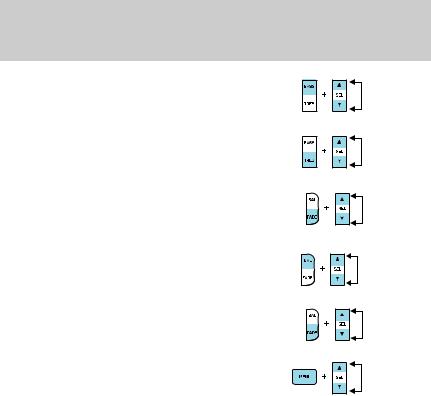
Entertainment Systems
6. Bass: Press BASS; then press SEL  /
/  to decrease/increase the bass output.
to decrease/increase the bass output.
Treble: Press TREB; then press SEL  /
/  to decrease/increase the treble output.
to decrease/increase the treble output.
7. Select: Use with Bass, Treble, Balance and Fade controls to adjust levels. Use with MENU to set the clock and engage RDS.
8. Balance: Press BAL; then press SEL  /
/  to shift sound to the left/right speakers.
to shift sound to the left/right speakers.
Fade: Press FADE; then press SEL  /
/  to shift sound to the rear/front speakers.
to shift sound to the rear/front speakers.
9. Menu: Press MENU and SEL to access clock mode, RDS on/off, Traffic, Program type, Show type and Compression modes.
Traffic: Allows you to hear traffic broadcasts. With the feature ON, press SEEK or SCAN to find a station broadcasting a traffic report (if it is broadcasting RDS data). Traffic information is not available in most U.S. markets.
FIND Program type: Allows you to search RDS-equipped stations for a certain category of music format: Classic, Country, Info, Jazz, Oldies, R&B, Religious, Rock, Soft, Top 40.
Show TYPE: Displays the station’s format (i.e., Jazz, Classic, Country, Info, Oldies, R&B, Religious, Rock, Soft and Top 40).
Show NAME: Displays station’s call letters. Show NONE: Nothing appears in the display.
Compression: Brings soft and loud CD passages together for a more consistent listening level.
Setting the clock: Press MENU until SELECT HOUR or SELECT MINUTE is displayed. Use SEL to manually increase ( ) or decrease (
) or decrease ( ) the hours/minutes. Press MENU again to disengage clock mode.
) the hours/minutes. Press MENU again to disengage clock mode.
26

Entertainment Systems
10. Memory presets: To set a
station: Select frequency band AM/FM; tune to a station, press and
hold a preset button until sound
returns. In CD mode, press to move between CDs.
This radio is equipped with six station memory preset controls which allow you to set up to six AM stations and 12 FM stations (six in FM1 and six in FM2).
11. CD: Press to select CD mode.
Seamless play: In CD mode, the transition between the end of one
CD and the beginning of another will not contain delay time unless SEEK or a preset control is pressed.
12. AM/FM: Press to select a frequency band in radio mode.
Autoset: Allows you to set the
strongest local radio stations without losing your original manually set preset stations for AM/FM1/FM2 . Press and momentarily hold AM/FM. AUTOSET will flash on the display. When the six strongest stations are filled, the station stored in preset 1 will begin playing. If there are less than six strong stations, the system will store the last one in the remaining presets. Press and momentarily hold to disengage (AUTOSET OFF will appear in the display.).
13. Power/volume: Press to turn ON/OFF; turn to increase or decrease volume levels.
14. Load: Press to load a CD. Press and hold to load up to six discs.
15. Shuffle: Press to play tracks in random order. Press SHUF to cycle through SHUF DISC, SHUF TRAC or SHUF OFF.
16. Scan: Press to hear a brief sampling of all listenable stations or CD tracks. Press again to stop.
27

Entertainment Systems
17. Disc/Tune: Radio: Press 
or |
to manually tune down or up |
||
the frequency band. |
|
||
CD: Press |
or |
to select the previous or next track on the CD. |
|
18. CD door: Insert a CD label side up.
REAR AUDIO CONTROLS (IF EQUIPPED)
The Personal Audio System allows the rear seat passengers to listen to one media source (radio, tape, CD, or CD changer if equipped) while the front seat passengers listen to another. However, front and rear seat passengers can not listen to two different radio stations simultaneously.
To engage, simultaneously press the memory preset controls 3 and 5. Press again to disengage.
1.Memory: Push successively to allow rear seat passengers to scroll through memory presets. Push in CD changer mode (if equipped) to advance to the next disc.
2.Seek: Press  or
or  to access
to access
the previous or next station, selection or track.
5 |
6 |
1 |
2 |
VOLUME |
MEDIA |
MEM |
SEEK |
4 |
|
|
3 |
3.Headphone jack: Plug a 3.5 mm headphone into the jack.
4.Headphone/speaker: Press to turn all speakers off (headphone mode). Press again to deactivate the headphone and activate system speakers.
5.Volume: Press + to increase and — to decrease volume levels. From the rear seat controls, volume can not be set higher than the front seat setting.
6.Media: Push to toggle between AM, FM1, FM2, tape, CD or CD changer mode (if equipped).
Plug a 3.5 mm headphone into either one of the two |
jacks. Press |
the  /
/  control to operate the headphones.
control to operate the headphones.
The rear speakers will cut out once the speaker on/off control is pressed. A soft audible sound may be heard from the rear speakers. The front
28

Entertainment Systems
speaker will remain playing for the front passengers. Press the  /
/  control again to deactivate the headphones (Personal Audio System).
control again to deactivate the headphones (Personal Audio System).
RADIO FREQUENCIES
AM and FM frequencies are established by the Federal Communications Commission (FCC) and the Canadian Radio and Telecommunications Commission (CRTC). Those frequencies are:
AM - 530, 540–1700, 1710 kHz
FM87.7, 87.9–107.7, 107.9 MHz
RADIO RECEPTION FACTORS
There are three factors that can effect radio reception:
•Distance/strength: The further you travel from an FM station, the weaker the signal and the weaker the reception.
•Terrain: Hills, mountains, tall buildings, power lines, electric fences, traffic lights and thunderstorms can interfere with your reception.
•Station overload: When you pass a broadcast tower, a stronger signal may overtake a weaker one and play while the weak station frequency is displayed.
CASSETTE/PLAYER CARE
Do:
•Use only cassettes that are 90 minutes long or less.
•Tighten very loose tapes by inserting a finger or pencil into the hole and turning the hub.
•Remove loose labels before inserting tapes.
•Allow tapes which have been subjected to extreme heat, humidity or cold to reach a moderate temperature before playing.
•Clean the cassette player head with a cassette cleaning cartridge after 10–12 hours of play to maintain good sound/operation.
Don’t:
•Expose tapes to direct sunlight, extreme humidity, heat or cold.
•Leave tapes in the cassette player for a long time when not being played.
29

Entertainment Systems
CD/CD PLAYER CARE
Do:
•Handle discs by their edges only. Never touch the playing surface.
•Inspect discs before playing. Clean only with an approved CD cleaner and wipe from the center out.
Don’t:
•Expose discs to direct sunlight or heat sources for extended periods of time.
•Insert more than one disc into each slot of the CD changer magazine.
•Clean using a circular motion.
CD units are designed to play commercially pressed 12 cm (4.75 in) audio compact discs only. Due to technical incompatibility, certain recordable and re-recordable compact discs may not function correctly when used in Ford CD players. Irregular shaped CDs, CDs with a scratch protection film attached, and CDs with homemade paper (adhesive) labels should not be inserted into the CD player. The label may peel and cause the CD to become jammed. It is recommended that homemade CDs be identified with permanent felt tip marker rather than adhesive labels. Ball point pens may damage CDs. Please contact your dealer for further information.
AUDIO SYSTEM WARRANTY AND SERVICE
Refer to the Warranty Guide for audio system warranty information. If service is necessary, see your dealer or qualified technician.
30
